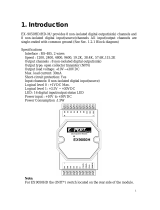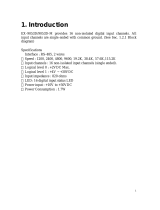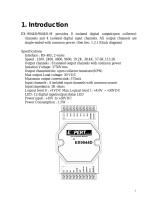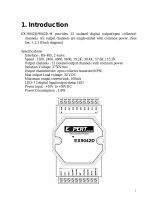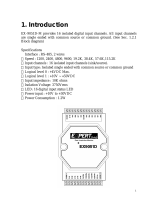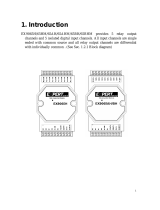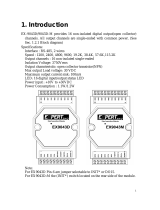
5.3.4 $AAPN[parity-bit] .................................................................74
5.3.5 $AAON[stop-bit]....................................................................76
5.3.6 $AA6[ID].................................................................................78
5.3.7 $AA7........................................................................................79
5.3.8 $AAC[delimiter].....................................................................80
5.3.9 $AAD.......................................................................................81
5.3.10 [delimiter]AA[bypass] ...........................................................82
5.3.11 $AAKV....................................................................................83
5.3.12 $AATN[CrLfmode]................................................................84
5.3.13 $AAW......................................................................................86
5.3.14 $AAXV....................................................................................87
5.3.15 $AAYN....................................................................................88
5.3.16 $AAZNV.................................................................................89
5.3.17 #** ...........................................................................................91
5.3.18 $AA4........................................................................................92
5.3.19 $AA5........................................................................................94
5.3.20 $AAF.......................................................................................96
5.3.21 $AAM......................................................................................97
5.3.22 $AA2........................................................................................98
5.3.23 ~** ...........................................................................................99
5.3.24 ~AA0......................................................................................100
5.3.25 ~AA1......................................................................................101
5.3.26 ~AA2......................................................................................103
5.3.27 ~AA3ETT..............................................................................105
5.3.28 ~AA4P & ~AA4S..................................................................106
5.3.29 ~AA5P & ~AA5S..................................................................107
5.3.30 $AAU.....................................................................................108
5.3.31 $AAL[data]...........................................................................110
5.3.32 $AAR.....................................................................................112
5.3.33 $AAJN[timeout]...................................................................113
5.3.34 $AAGN[triggerlevel]............................................................115
5.3.35 @AA[data]............................................................................116
5.3.36 #AABBHH............................................................................118
5.3.37 #AABCDD ............................................................................119
5.3.38 $AAEV..................................................................................120
CHAPTER 6 APPLICATIONS.........................................................................122
6.1. CNNECTING TO THE HP34401A...........................................................122
6.1.1 Connect the I-752N module to the HP34401A...................122
6.1.2 Connecting a PC to the HP34401A.....................................122
6.1.3 Connecting a single I-7522 to a single HP34401A .............124
6.1.4 Connecting multiple I-7522 modules and multiple HP34401A
126
6.1.5 Connecting a single I-7523 modules and two HP34401A..128
6.1.6 Connecting multiple I-7523 modules and multiple HP34401A
130
6.2. TYPICAL APPLICATIONS ......................................................................132
APPENDIX A MINIOS7 UTILITY.................................................................................141
APPENDIX B 7188XW.EXE...........................................................................................142
APPENDIX C MANUAL ERROR ANNOUNCEMENT................................................147
I-7521/I-7522/I-7522A/I-7523/I-7524/I-7527 User’s Manual,Ver2.3 Aug.2008,xxxx
3




















